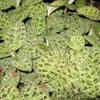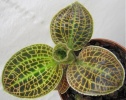Culture of Macodes
The Diamonds of the Jewel Orchids
Jewel Orchid Cultural Information by Michael Dorris Macodes was created in 1840 by Lindley in "Genera and Species of Orchidaceous Plants". The genus meaning "length" in Greek referring to the comparatively long lip. There are about ten species in the genus. It is frequently mistaken for Anoectochilus. A number of species and forms. The flowers of this genera have a slightly twisted column. The foliage of the species have little in common.
 Macodes petola
Macodes petola was named in 1840 by Lindley in "Genera and species of Orchidaceous plants".
It is found from Sumatra to the Philippines in lowland and lower montane forests as a warm growing terrestrial with creeping rhizomes.
Comber records it growing "in damp forests which do not have a long dry season, in rather dark situations from 300 - 1,400 m."
The plant has an inflorescence up to 8 in (20 cm) tall, with few flowers seemingly smaller then you would expect for even a jewel orchid. Blooms in winter.
Macodes petola
Macodes petola was named in 1840 by Lindley in "Genera and species of Orchidaceous plants".
It is found from Sumatra to the Philippines in lowland and lower montane forests as a warm growing terrestrial with creeping rhizomes.
Comber records it growing "in damp forests which do not have a long dry season, in rather dark situations from 300 - 1,400 m."
The plant has an inflorescence up to 8 in (20 cm) tall, with few flowers seemingly smaller then you would expect for even a jewel orchid. Blooms in winter.
M. petola is one of the most common jewel orchids on the market because its easy to clone and has such good color. There are a number of varieties: var. petola with yellow veins, var. robusta, with longitudinal veins only, and var. argenteoreticulata syn. var. javanica with white transverse veins that join with the longitudinal veins. There is a red form but it more burgundy then red and is regarded as being the Sumatran form. The standard form does develop a red tint in rich light. This orchid has very nice green yellow leaves, good netting, some of the best patterns of any jewel orchid.
It clumps and spreads like a weed. Mac. petola is easy to grow even if you don't know anything about orchids. Like most jewel orchids it does tend to fall apart after it flowers. Reducing the water by half helps prevent this.
Mac. petola is in demand as a stimulant in traditional Borneo medicines, but I felt nothing and its not the best tasting jewel orchid. L. Glicenstein of the former Hoosier Orchids recounts a tradition in Java where children just learning to read, eat Mac. petola to help them read as the veins resemble the letters of the local language.
 Macodes lowii
is not the same as Anoectochilus lowii. Found in Borneo as a terrestrial orchid that blooms in the summer, there is evidence it grows north of Borneo.
Macodes lowii
is not the same as Anoectochilus lowii. Found in Borneo as a terrestrial orchid that blooms in the summer, there is evidence it grows north of Borneo.
 Macodes sanderiana
is a warm growing terrestrial from Papua New Guinea from 1000 to 2000 ft (400 to 800 m) growing in leaf-litter on rocks with almost oval leaves that begin like Mac. petola but as they mature take on orange tones and gradually the squares of the geometric pattern turn black with lime green veins at the leaf base, yellow gold in the middle and orange towards the leaf tip.
The whole leaf shifts and changes its color as it ages ending in a black collection of squares with yellow netting and a purplish underside.
Blooms in the fall and winter on a 10 to 12 inch (25 to 30 cm) tall thin spike with few, brown flowers that look like the head of a bee.
A spike that might be best pinched off.
After it flowers the plant seems to dissolve into a yellow shriveled mess until it puts out a new shot or two and starts over again.
Overall slow growing. Few leaves, 3 in (8 cm).
Does not creep but clumps well.
Most often this plant is mistaken for Dossinia marmorata, Mac. sanderiana is not burgundy.
Macodes sanderiana
is a warm growing terrestrial from Papua New Guinea from 1000 to 2000 ft (400 to 800 m) growing in leaf-litter on rocks with almost oval leaves that begin like Mac. petola but as they mature take on orange tones and gradually the squares of the geometric pattern turn black with lime green veins at the leaf base, yellow gold in the middle and orange towards the leaf tip.
The whole leaf shifts and changes its color as it ages ending in a black collection of squares with yellow netting and a purplish underside.
Blooms in the fall and winter on a 10 to 12 inch (25 to 30 cm) tall thin spike with few, brown flowers that look like the head of a bee.
A spike that might be best pinched off.
After it flowers the plant seems to dissolve into a yellow shriveled mess until it puts out a new shot or two and starts over again.
Overall slow growing. Few leaves, 3 in (8 cm).
Does not creep but clumps well.
Most often this plant is mistaken for Dossinia marmorata, Mac. sanderiana is not burgundy.